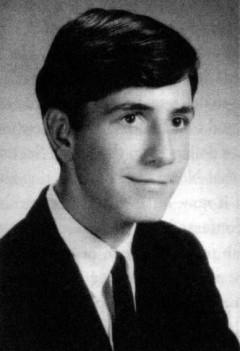Lester Bangs, El Cajon, and ‘A Box Full of Rocks’
By Jim DeRogatis

Lester Bangs, El Cajon, and ‘A Box Full of Rocks’
By Jim DeRogatis
Though I am, of course, enthusiastically biased on this topic, I have long thought that the life of pioneering rock critic and gonzo-literary hero Lester Bangs is prime fodder for the right filmmaker.
Granted, as feature films go, it would be hard to top the great Philip Seymour Hoffman’s portrayal of the man in Cameron Crowe’s Almost Famous, which was released in 2000, the same year as my biography, Let It Blurt.
But the three eras of Bangs’ life each are ripe for documentary exploration, starting with his formative early years outside San Diego in the idiosyncratic, time-warp suburb of El Cajon; continuing with his work in post-riot Detroit at Creem magazine, and ending with the realization of many of his dreams as well as his ultimate disillusionment during New York City’s punk explosion in the late ’70s. (Bangs died in 1982 at the age of 33.)
It’s the lesser-known first third of the writer’s story that is explored in A Box Full of Rocks, a new documentary by Grossmont College writing teacher Raul Sandelin. (Bangs attended that fine institution, and though he did not graduate and tanked in every course except English and Creative Writing, Sandelin did manage to get him a plaque on the wall a few years back, considerable progress a decade after my visit didn’t even turn up a single copy of the immortal anthology Psychotic Reactions and Carburetor Dung in any of the local libraries.)
“I started the Lester Bangs Archive at Grossmont College in 2009,” Sandelin recently told The San Diego Reader. “Another instructor, Sydney Brown, started the Lester Bangs Memorial Reading at Grossmont. The premiere of A Box Full of Rocks coincides this year with the fifth-anniversary memorial reading [on Oct. 22].”
Though Bangs often wrote about El Cajon as a conservative, stifling trap that he longed to escape—the town’s name literally translates to “the box”—Sandelin believes that the very absence of the rock ’n’ roll energy thriving in bigger, hipper cities in the mid- to late-’60s is what drove the rebellious young Jehovah’s Witness and a small circle of fellow writers and musicians to form their own aesthetic. Equally based on bebop records and Beatnik novels purchased at the local dime store and trashy one-hit-wonder garage bands playing on AM radio in between the slicker sounds of the British Invasion and San Francisco’s Summer of Love, thus was nurtured the seeds of punk.
The key survivors of that curious circle appear in the film—Milt Wyatt, Jerry Raney, Jack Butler, Gary Rachac, and Rob Houghton—along with, I should note in the interest of disclosure, yours truly. And Thee Dark Ages, the band for which the man occasionally played wild harmonica, reformed to provide the soundtrack. (Some of its members later went on to Iron Butterfly and the Beat Farmers, El Cajon’s other big claims to rock ’n’ roll fame.)
Though the film will certainly be welcome at festivals such as South by Southwest and CIMMFEST, Sandelin knows it never will be a huge success, even by documentary standards. He envisions an eventual D.I.Y. release on DVD in addition to floating the movie as a free download or stream on the Web.
Like many a filmmaker these days, Sandelin is hoping that a Kickstarter campaign will help him reach the finish line. With less than three weeks to go, it’s more than a little short of its goal of raising $13,000. But if there’s a more worthy creative cause out there deserving of a little coin at the moment, I can’t think of it. Just check out the seven-and-a-half-minute trailer/sampler.
Follow me on Twitter @JimDeRogatis or join me on Facebook.